Planet order: The eighth planet from the Sun
Distance from Sun: 4.5 billion km
Mass: 102.4x10^24 kg
Diameter 49,493 km
Rotation: 17.24 hours
Planet description: Planet Neptune is eighth planet from Sun. It is the fourth-largest planet by diameter and third largest by mass. Neptune is 17 times the mass of Earth and slightly more massive than its near-twin Uranus. Neptune consists of upper cloud tops, atmosphere, mantle and core. The temperature at clouds top is -210o C (-346o F). The large moon name is Triton. Neptune has much more gas and ice inside than Earth.
Interesting Facts:
Neptune was the god of the water and was a son of Chronos and a brother of Jupiter (Zeus) also brother of Pluto (Hades). Neptune's weather is similar to Jupiter and Saturn.
Distance from Sun: 4.5 billion km
Mass: 102.4x10^24 kg
Diameter 49,493 km
Rotation: 17.24 hours
Revolution: 165 years
# of Moons: 13
Type of Planet: Jovian
# of Moons: 13
Type of Planet: Jovian
Planet description: Planet Neptune is eighth planet from Sun. It is the fourth-largest planet by diameter and third largest by mass. Neptune is 17 times the mass of Earth and slightly more massive than its near-twin Uranus. Neptune consists of upper cloud tops, atmosphere, mantle and core. The temperature at clouds top is -210o C (-346o F). The large moon name is Triton. Neptune has much more gas and ice inside than Earth.
Interesting Facts:
Neptune was the god of the water and was a son of Chronos and a brother of Jupiter (Zeus) also brother of Pluto (Hades). Neptune's weather is similar to Jupiter and Saturn.




